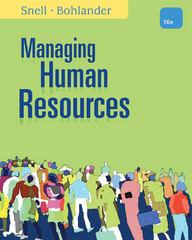When the financial services industry tumbled into crisis in June 2007, Capital One chairman and CEO Richard
Question:
When the financial services industry tumbled into crisis in June 2007, Capital One chairman and CEO Richard Fairbank issued a mandate to strip $700 million out of the company’s operating costs by 2009. The cost reduction plan includes consolidating and streamlining functions, reducing layers of management, and eliminating approximately 2,000 jobs. The mandate did not set off a mad scramble in workforce planning, however. Instead, the planning staff simply added new defined variables to their simulations and modified their projections for the company’s talent needs.
The key to workforce planning is to start with the long-term vision of the organization and its future business goals and work back from there,” says Matthew Schuyler, chief human resources officer for Capital One and its 27,000 employees. “We anticipate the strategic needs of the business and make sure that we have the workforce required to meet those needs. The $700 million mandate gives us goals and boundaries that we didn’t have before. We made the adjustments.” Capital One and other leading companies are developing a set of best practices for workforce planning that reach into the future for each business unit and evolve with corporate strategic planning. In an increasingly unstable global business environment, the value of a long-term vision is clear, but effective workforce planning requires dedicated resources, heavy analytics, and, perhaps most important, the full engagement of business unit leaders and line managers.
The workforce planning at Capital One stems from a process executed by a metrics and analytics group of 20 people, plus hundreds of executives, managers, and analysts pulled from all the business lines and corporate functions. Leaders and analysts from the business lines work in blended teams with human resources generalists and members of the metrics group to build models for each line and the entire world force.
The models flow to Schuyler, who reports directly to the CEO. “You have to garner your long-term vision of the organization from your seat at the table and from the time you spend with business leaders, immersed in places where you can get data,” Schuyler says. “You have to probe the business leaders and know the business leaders and know what their endgame looks like.” Planning varies by business line. Some lines are stable, while others are restructuring or moving through rapid growth.......
Questions
1. Why do you think it’s important for Capital One to calculate the “disengagement” factor of its employees when it comes to workforce planning?
2. What merits do you see to breaking down the planning process by business units through multiple layers of leaders? Do you see any drawbacks of doing so?
Step by Step Answer:

Managing Human Resources
ISBN: 9781133707394
16th Edition
Authors: James Stewart, Scott A Snell, George Bohlander





